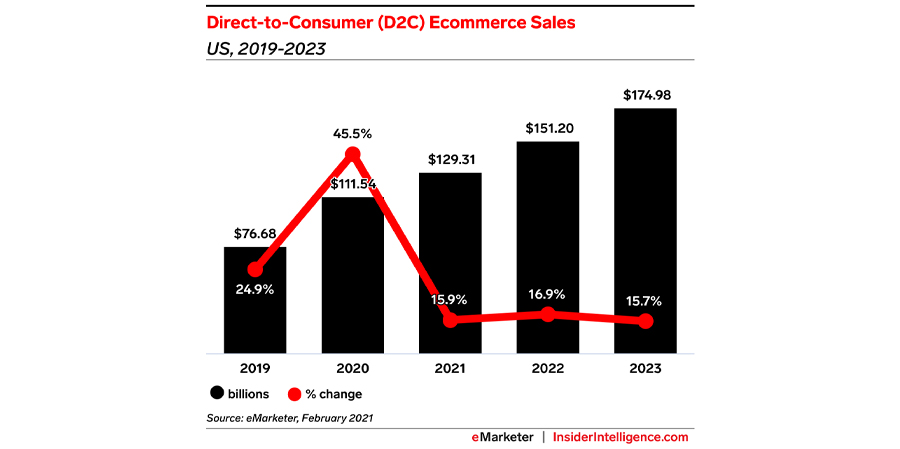According to eMarketer’s forecast, US direct-to-consumer (D2C) ecommerce sales will reach $151.20 billion in 2022, an increase of 16.9% compared to this year. And while D2C purchasing will only account for 2.5% of total retail sales in the year ahead, these brands have challenged and successfully disrupted the retail industry by diversifying consumer experience.
Originally, D2C referred to digitally native brands without a physical storefront that sold directly to consumers by website. Many founders of D2C companies say they went to market with the intent to solve a perceived pain point in the marketplace that they personally experienced. Over time, D2C has evolved into a business model with legacy brands, like Nike and The Clorox Company, having D2C components.
Pure-play D2C companies like Peloton, Warby Parker, and HelloFresh, for example, curate every interaction—from marketing to delivery—with customers and share distinct commonalities that have enabled D2Cs to thrive:
Attract consumers through intentional marketing. Customer acquisition can be expensive for D2Cs. However, the D2C model offers companies control over each product’s marketing. Shane Pittson, vice president of growth at Quip, told eMarketer that launching as a D2C allowed the oral hygiene provider better “data and perspectives” for conversations with retailers, setting the company up for success.
Offer customers unique, quality products. Because of their direct offerings for customers, each D2C is challenged with convincing customers that it offers something consumers can’t find anywhere else. For Ricky Joshi, co-founder and chief strategy officer at mattress company Saatva, this means avoiding the “glitz and glitter” that surrounds typical D2C brands and instead “sticking to the value proposition and the philosophy of the company as it started.”
An ability to convert “add to cart” into “proceed to checkout.” Like every ecommerce company, D2Cs face the challenge of converting impressions into actual purchases. Strategies for pushing consumers to reach for their wallets look different for each D2C. Kate MacCabe, vice president of product at Brooklinen, shared with eMarketer that the bedding company has actually benefited from limiting consumers’ customizations, streamlining the path to purchase in the process. For other D2Cs, increasing conversions may involve adopting partnerships with companies like Shopify to streamline checkout.
Evolve alongside customer needs. To stay competitive, D2Cs must diversify consumer experience beyond selling fixed products on a static website. For many D2Cs, this means evolving beyond the pure D2C model to partner with external resources in the spirit of growth. Footwear brand Allbirds and eyewear provider Warby Parker have brick-and-mortar stores to bring customers offline. Quip partners with existing brick-and-mortars, like Target, to sell products. Many D2Cs have also expanded beyond their initial hero offerings: Allbirds now sells apparel and men’s razor company Harry’s has deodorant available. These offerings reflect an evolution of these brands’ original models while holding true to their original spirits.
…
This article first appeared in www.emarketer.com
Seeking to build and grow your brand using the force of consumer insight, strategic foresight, creative disruption and technology prowess? Talk to us at +971 50 6254340 or mail: engage@groupisd.com or visit www.groupisd.com/story




